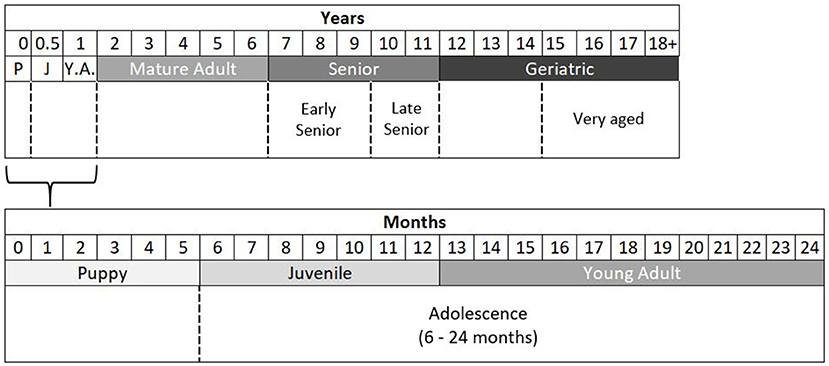I recently learned that the idea that dogs are seniors “by age seven” came only from a study of border collies, not from a spectrum of how dogs of different breeds age. Researchers also often focus on beagles for these studies. A new paper published in April 2021 suggests 6 new categories to understand a dog’s age. Let’s take a look.
More…
It turns out there really isn’t a consistent model to classify a dog’s age throughout life. Because of this, it is difficult for researchers to compare and use previously published work on canine aging.
There is debate about additional subcategories. For example, dogs undergo important changes during puberty and when they are older than 12 or 14 years. However, as a starting point, this timeline graph will help you place your dog on an aging spectrum.
Like dogs age categories
The study’s authors explain that “These categories are designed to capture age-related developmental trajectories for most dog breeds.” These groups, they say, “support educational programs that educate owners about what behavioral changes to expect in their dog as they grow older.” are, but they cannot be used to reflect health-related needs related to race-specific mortality.”
The 6 categories are as follows:
- Puppy – 0-5 months
- Cub – 6-12 months
- Young adult – 13-24 months
- Mature adult – 2-6 years
- Seniors – 7-11 years (with these possible subcategories):
7-9 years = early senior
10-11 years = later senior - Geriatrics – 12-18+ years (with these possible subcategories):
12-14 years = geriatric
15-18+ years = very old
Do dogs live longer?
Apparently there is a recent newspaper about dogs in the US that a “higher mean lifespan of 15.4 years” than a previous study of dogs in the UK. So, that’s interesting.
It seems my friends live with dogs that make it into their teens.
Heck, our old big boy Ginko made it 4 months short of his 16th birthday. That makes my new goal to make our current crew over 16 years old. Before Ginko, the oldest dog I’ve ever had was Penelope, a Dalmatian who was 14 when we lost her.
What about giant dogs?
Well, technically, giant dogs die while they are still full grown adults or very early seniors, so old dog age charts where large dogs age faster and are labeled as geriatric (when their brains and behaviors don’t reflect such mental declines)” Mask”.[s] the severity of problems associated with early mortality in short-lived breeds,” the paper’s authors said.
They go on to say: “Morbidity and mortality in old age are acceptable, even inevitable. However, when we see high morbidity and mortality in an animal that can be objectively classified as young, that should worry us.”
What does this mean about the age of dogs?
Well, dogs over the age of 12 tend to see “more cognitive impairment” than dogs in their earlier senior years. And dogs older than 15 years “have a much higher incidence of cognitive impairment” than other older dogs.
Ginko suffered from canine cognitive disorders in his later years, including loss of housetraining (which was also caused by neurological problems) and random wandering around the house, whining, barking, and trouble sleeping.
Be sure to talk to your veterinarian if you notice any such changes in your older dog.
This special senior dog food with medium chain triglycerides (MCT) has helped Ginko so I’ll probably switch our current dogs to this at some point as they get older. (PS: I no longer have a relationship with the dog food company, but I do feed Pro Plan. Also, that link is an old post. The giveaway is no longer live.)


